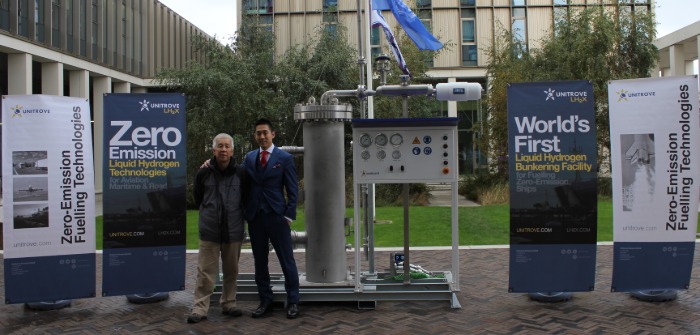A liquid hydrogen bunkering facility for fueling zero-emission ships has been unveiled by clean energy solutions company Unitrove at the COP26 climate change conference in Glasgow, UK.
Unitrove believes that the bunkering facility, said to be a world first, is vital to fuel vessels as the international shipping sector accounts for one billion metric tons of global CO2 emissions and 400,000 premature deaths each year. This is due to ship smokestacks emitting harmful particulate matter, sulphur oxides and nitrogen oxides.
Prior to COP26 commencing, the International Chamber of Shipping (ICS) submitted plans to the International Maritime Organization (IMO) asking for measures to be implemented that would help the maritime sector achieve net zero CO2 emissions by 2050.
The ICS is currently pushing governments to double the target set by the IMO, which is a 50% reduction in international shipping emissions by 2050.
The company previously delivered the UK’s first liquefied natural gas bunkering facility at Teesport in May 2015, with Unitrove’s CEO, Steven Lua, saying his ambition was to enable clean, affordable, reliable, and sustainable fueling options for ships at every international port. Lua now believes that hydrogen will play a vital role for larger vessels and that it can plug the gap where electric and compressed hydrogen options are not possible.
“The global maritime sector is one of the most polluting in the world. It’s estimated that just a handful of the worst-polluting mega ships on our oceans today produce more pollution than all the world’s cars put together,” commented Lua. “To achieve net zero by 2050 needs the combined will of the industry and governments.
“As well as building new vessels, we need to ensure the infrastructure is in place. At this moment in time, there’s no clean-fuel bunkering infrastructure – it’s practically non-existent. Without zero-emission fueling infrastructure, the drive for zero-emission ships will falter. In terms of infrastructure, there’s nothing significant in place today, but we are here to change that. The average lifespan of a large ship is anywhere between 20 to 40 years, meaning any ship procured today could potentially still be operating well beyond 2050.”
Lua continued, “We already see very early signs of light-duty vessels being battery-driven or powered by compressed gaseous hydrogen, but liquid hydrogen will allow us to serve the heavier portion of the shipping fleet where we hope to have a much larger impact.
“We are also exploring options including ammonia, liquid organic hydrogen carriers, and solid hydrogen in the form of sodium borohydride. However, we understand that priority is currently being given to the development of international standards and regulations for pure hydrogen, and this could play a significant factor in the long run.”
The showcase took place at the International Maritime Hub, hosted by the City of Glasgow College and Maritime UK – the industry body for the £46bn (US$62bn) UK maritime sector.
“Unitrove’s pioneering energy solutions deserve their place on the world stage at COP26, joining Maritime UK to set the agenda for green maritime,” said Ben Murray, chief executive, Maritime UK. “We are bringing the sector together to showcase best practice and accelerate progress towards net zero across the global industry. We have always been an island of maritime pioneers, and through closer collaboration, and further co-investment with government, we can rule the green waves of the future and meet the UK’s net zero target together.”



